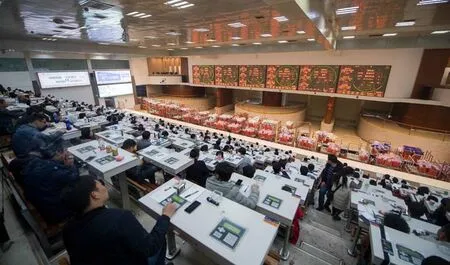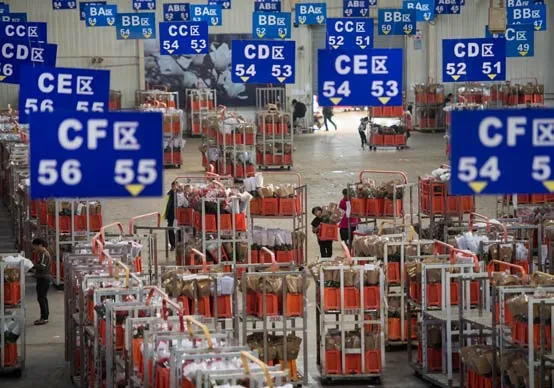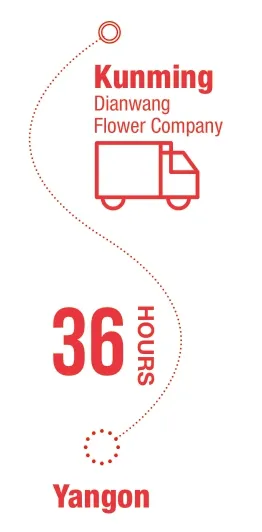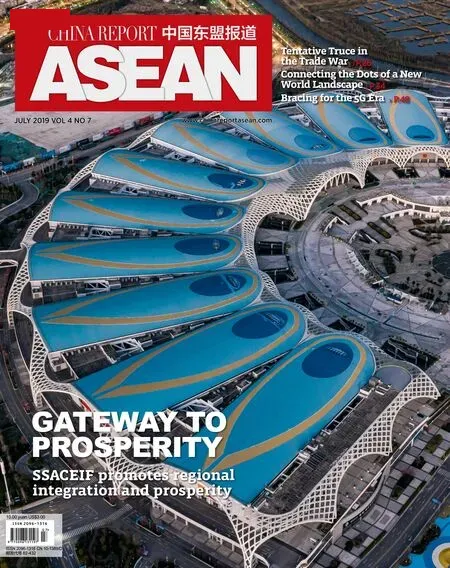YUNNAN FLOWERS LINING THE SILK ROAD
By Wang Fengjuan

Farmers pick and handle fresh flowers at the Shilin Yi Autonomous County Flora Industrial Park.
Fresh cut flowers move from southwest China to Southeast Asia
As the largest cut flower trading market in Asia,KIFA has become a“market weathervane”and “price barometer”for cut flowers in China and greater Asia.
T he flower sheds in the suburbs of Kunming,capital of Yunnan Province,are often bustling with flower farmers harvesting roses in the early morning. “Cut flowers have to be kept fresh to get the best market price,” a farmer explained. “Cut flowers go through five stages from buds to bloom. The best time to harvest flowers is stage 2 when the buds are ready to bloom. By the time they reach consumers,they will be at stage 4 or 5 and blossoming fully.”
“Yunnan Flower” has become a famous floral brand in China, and Kunming Dounan Flora Market is Asia's largest cut flower trading center. In 2018, 6.99 billion cut flowers were sold to more than 50 countries and regions including Japan, South Korea,Singapore, Vietnam and Saudi Arabia. Southeast Asia has become an important overseas market for cut flowers from the province.
Market Weathervane

On the east side of Erhai Lake in Kunming is the Kunming International Flora Auction Trading Center (KIFA),the largest of its kind in China.Cut flowers from all over the province arrive at the center's 20,000-square-meter logistics area from early morning till noon. Statistics from the Dounan Flowers E-Trade Center(DFETC) show that the daily supply of cut flowers is 4.6 million, with a turnover rate of 96.67 percent. The prices of high-quality flowers have been on the rise.
Before auctions in the afternoon, each bouquet of flowers is subject to quality inspection and classification according to its species, grade and quantity.
The daily auction starts at 3 p.m. The auctioneer informs traders of relevant information about the flowers for sale while the clocks on the wall start to tick. The traders have only a few seconds to decide on a bid. Ding Hui is a trader who follows the dropping price on the clock closely. When a good price appears on the clock, the bidder must press his button within three seconds to make a bid.
“It's a full-time job,” said Ding. “You have to follow the auctioneer closely or you'll miss your chance to bid for what you want.” Ding has been in the business for 13 years, and his sales network now extends to Thailand,Cambodia and other Southeast Asian countries. As a floral businessman, he monitors the pulse of the market. “The market measures spikes and falls through average price,”he explained. “For example,the average price of a 20-piece bouquet of grade-A corolla rose is 38 yuan. The price for each piece can be from 1.5 to 2.1 yuan according to quality.”
Each afternoon, Ding and his fellow traders concentrate on the clocks at the auction center to make quick bid decisions.

The development of“Yunnan Flowers” has been export-oriented. To connect flower farmers to the overseas market, the Yunnan Provincial Government signed a cooperative agreement with the Netherlands' Aalsmeer Flower Auction, the largest flower auction in the world, in 1999 to build an auction center of its type in Kunming. The center was designed to adopt the “Dutch Reverse Auction”mode in which the price starts high and works its way down,and bidders may have only a split second to bid before the products are sold to someone else. After three years of planning and construction, the KIFA kicked off on December 20, 2002. Thanks to the arrangement, farmers can concentrate on the cultivation of high-quality flowers while traders can focus on bidding.
As the largest cut flower trading market in Asia,KIFA has become a “market weathervane” and “price barometer” for cut flowers in China and greater Asia. The auction center's daily volume of trade is 4 to 4.6 million flowers, making a direct impact on the price of cut flowers in the Chinese and Southeast Asian markets.
The Yunnan Dounan Flower Industry Group has built a modern flower supply chain and an integrated flower transaction and service platform consisting of electronic settlement,electronic auction, remote auction, network transactions,supporting information services and logistics services and online and offline financial services, which have reduced procurement costs and wastage of flowers during transport and delivery.
“This business model has safeguarded a fair and competitive market”, remarked Li Angdi, a specialist with Yunnan Dounan Flower Industry Group. “In the traditional free market, it was difficult for traders to make choices without transparent pricing. In this auction center,high-quality flowers can be acquired at the best prices—a win-win deal for both farmers and traders.”
Flowers Along the Silk Road

Fresh flower auction at the Kunming International Flora Auction Trading Center (KIFA).

Fresh flowers ready for auction at the Kunming International Flora Auction Trading Center (KIFA).

Roses packed into a minivan at the Kunming Dounan Flora Market.
Late at night, workers at a flower packaging workshop sort flowers and get them ready for a 20 to 40-hour journey to flower shops in Singapore,Thailand, Vietnam, Cambodia and other Southeast Asian countries.
“Thailand has strong demand for carnations, roses and lilies,” said Ma Na, a local trader. “Thailand is a tropical country. It depends on imports from temperate zone countries for these flowers.They can also import from the Netherlands or African countries. But the distance from Kunming to Bangkok is much shorter, which saves a lot on transportation costs.”
At the Yangon Flower Market, 30 percent of the roses,lilies and chrysanthemums are imported from Yunnan.Some flowers are sold in the local market and others are sold to the markets in other parts of Myanmar. Kunming Dianwang Flower Company specializes in the export of cut flowers to Myanmar and Cambodia. From 5 to 6 p.m.every day, its commodities depart Dounan Flora Market.The next morning, they are cleared by Chinese customs at Ruili border crossing and enter Myanmar through Muse border crossing. It takes about 36 hours to complete the whole journey to Yangon.

It takes about 36 hours to complete the whole journey of cut flowers from Kunming to Yangon.
Development of the flower industry at Dounan is a microcosm of the industry across the province. Blooming flowers year-round are known as one of the “18 Oddities of Yunnan” (18 things that happen only in the province). Yunnan,Kenya in Africa and Colombia and Ecuador in South America are known as the world's top three areas for flower production.
Southeast Asia has been the traditional market for Yunnan flowers. Thanks to construction of the Belt and Road, industrial cooperation between China and Southeast Asian countries has injected new impetus into bilateral trade. After completion of the Kunming-Bangkok International Expressway,Yunnan cut flowers can be transported to Bangkok through cold chain logistics.
Established in 1995, the Kunming International Flower Expo (KIFE) has evolved into a leading flower industry event in Asia, showcasing the province's development of the flower industry in recent years and playing an important role in the development of domestic and foreign markets and brand building for Yunnan. The expo has attracted diplomats and traders from Thailand,Vietnam, Myanmar, Cambodia,the Netherlands, Israel and other countries. Yunnan is leveraging its specialty flower industry to seize greater opportunities afforded by the Belt and Road and generate greater prosperity.
Development of the flower industry at Dounan is a microcosm of the industry across the province. Blooming flowers year-round are known as one of the “18 Oddities of Yunnan”.

